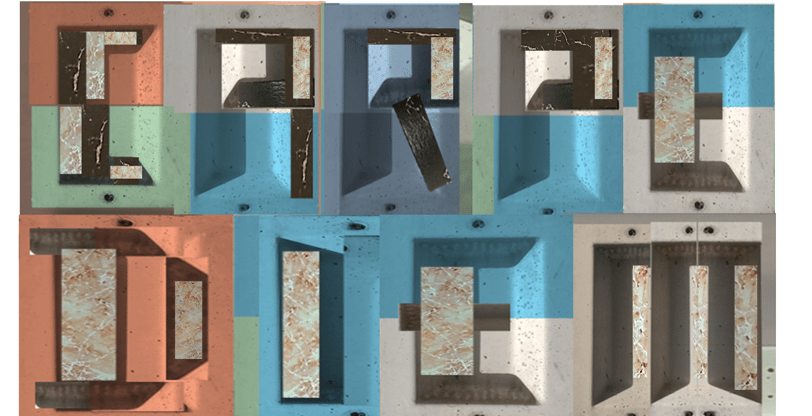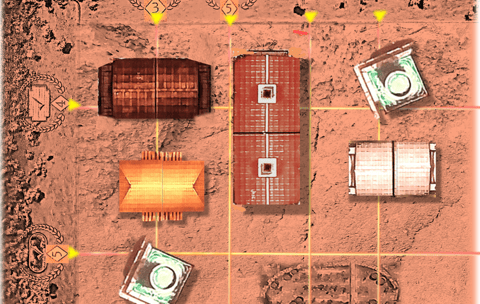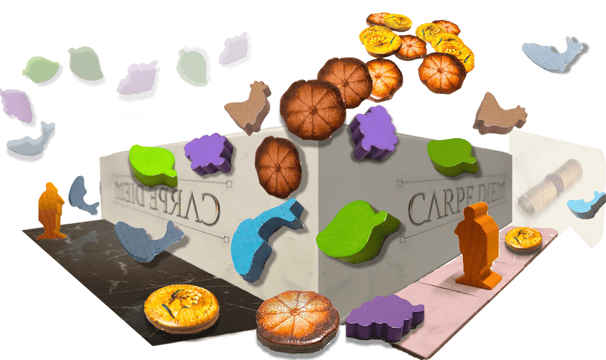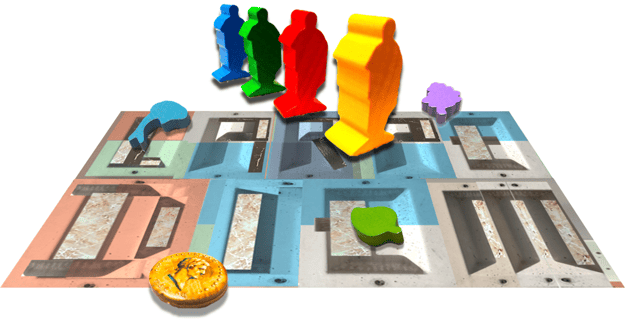
Carpe Diem: I'm Seized!
A review of Carpe Diem
Chris Sanderson


'Car-pe Di-em …’
Say the words slowly and I'm there, brooding over my city district nest like an architect hen.
Or I'm taking another turn around my boardgaming delicatessen, lost in this cerebral world of tasty scheming.
Carpe Diem … I’m seized.
I don’t mind that the Roman theme comes peeling off at the corners (stock Latin name, marble-veneered components, etc.) I’m not fussy. I even take it as a kind of backhanded compliment to my boardgamer’s intelligence. I don’t need cheap thematic trinkets to get me hooked.
If a good game is like a decent curry – a bunch of zingy flavors rolled into one defining taste – then Carpe Diem is a Shahi Lamb Korma.
It has the rich creaminess of things becoming other things – fish, hens, leaves and grapes being smoothly upgraded to gold; bread being sublimated into currency and flexible movement.
Straight square tile-laying gives an earthy, velvety base of town construction shot through by tangy frame goal bonuses.
End-of-phase goals lend a fruity anticipative sweetness, perfectly enhanced by fountain bonuses that provide a mild ‘chili’ kick to your overall points total.
With all that palette-pleasing, who cares if the theme is pseudo (sorry, ‘quasi’)?
And what if some tiles' buildings look like an aerial view of World War Two Anderson shelters?
Or if my district vaguely resembles a satellite image of Martian research base installations complete with a gridded laser surveillance system?
Who knows what a Roman town district really looked like from the air anyway?


Such questions fade into insignificance as I place choice tiles with a deeply satisfying 'click' to complete crunchy building after crunchy building. It's a cozy place to be. No rough edges, everything cushioned against the vicissitudes of life. It's a captivating, whole-brain peanut-butter-on-toasted-waffle vibe.
In Carpe Diem City, things are low-key but vibrantly intense. You’ll be mesmerized by the anechoic absence of real Roman-life stall-setting and marketplace bustle as you click your bits of prefab buildings and landscapes together. You’ll conveniently skate over the nitty-gritty, in-your-face aspects of life to construct your city scheme. You're a behind-the-scenes planner, an architectural dilettante. You never get the dirt of Rome under your fingernails.
Perfect, don’t you think?
I mean, after a day of hassle at the office, who wants to play anything resembling work? I don't. I want to sit back in the CEO's chair for a short while, pull a few triggers and let the banal issues of life take care of themselves.
And they do. There may be no burgeoning game arc, but there are elements shaping everything you do. It's a balanced, precise hybrid that never hits sixth gear but comes with an array of subtle amortizations against shortfalls:
admin buildings ramp you up on a Business Class points track.
gold-roofed buildings turn everything golder with a soft click.
craftsmen buildings give a freebie chunk of lake or farm or whatever takes your fancy.
bread floats beyond itself on a lofty plane, in a twilight dimension of its own.
Hmm, that’s the second time I said something weird about bread. The bread is in fact quite an issue for some. It’s an excuse, they say, a stop-gap resource.
Personally, I appreciate the bread. Bread here is a safety net insurance plan/travel permit, that also happens to look like a blobby coral paperweight.
Well, it has been known to hold down my plans on more than one occasion.


Bread is a kind of outside-the-box presence more than a commodity. It’s like the insurance on your freezer –something to skip paying until something goes wrong, and then it's too late. Note: seize your bread while there's time! It's an all-round solid asset, quite decisive if you can get your hands on enough of the stuff.
Trouble is, early in the game you're usually too busy trying to do other things. Then in about the third phase, you'll often come to the point where you say, 'Ah, I wish I had more bread!' But by then it's getting too late to stock up.
And that's a fair picture of how the game goes generally. You'll often come to the point of regretting not having enough resources to complete a goal, because you were too busy constructing some massive, aircraft hangar-sized villa with more chimneys than a power station.
Chimneys! Another of Carpe Diem’s quirks. Instead of your hens hatching eggs, your villas sprout chimneys. Chimneys arc beyond the phases like a pension plan, crescendoing to the Grand Points Finale, where you’ll see how your chimney investment panned out.
And there you’ll also see how your fountain cards and frame goal bonuses paid off.
They can often bring decisive dividends. Fountains are the Oscars for your town’s starring features, and the frame goals reward the supporting role of town planner you played so unassumingly.
Really, nothing’s a loss here, everything’s premium. In retrospect there’s always a lot to relish, little to rue. So you missed a goal? Never mind, you’ll have gummy-candy grapes and fish ad nauseum to cover any shortfall, at least later in the game. (It’s only after phase one that you tend to get your wrist slapped with a points deduction.)
Rarely a gripe, seldom a dud harvest or project in Carpe Diem! Everything has a way of becoming a handle to seize something else. There are enough cogs, switches and triggers to deal with any blockage or provide a third or fourth option that may even turn out to be sweeter than your first. You're never definitively done out of anything.
In summary: Carpe Diem fills your shelves with tubes of all-purpose, no-nails construction adhesive to hold your best plans together in a satisfyingly coherent shape and at an affordable cost.
Grab it.


BoardGameGeek review here.
Hi, I am Chris Sanderson, an Englishman living near Madrid, Spain. Please send me your comments by email, or in BoardGameGeek through the links at the end of each game review.
© 2025. All rights reserved.